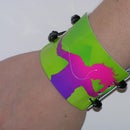Introduction: Easy Hollow Horns
Our other instructable for hollow horns was very wordy. So here's a different and easy method using Crayola Model Magic. Although there are eleven steps, there is not much reading :-)
Cost: about $25.
This method results in horns that are just as light, but definitely not as strong as the ones in our previous 'able. Painting these horns with foam glue, or a mix of foam glue and PVA glue, will make them a little stronger. Keep them short; no longer than these. If you want long horns with more than one curl, try our other instructable.
We make our horns hollow all the way through, because we like messing about with installing lights into them. Happy Halloween!
Step 1: Supplies
Crayola Model Magic - any colour. Or mix colours for a marbled effect. One 4oz bag makes one horn.
Twisted plant support (it's hollow).
Cheap plastic packaging tape.
Cooking/Baking paper.
Rolling pin.
a few small rubber bands.
a long piece of elastic, about 1cm or just under 1/2 an inch wide.
Foam glue.
Wirecutters or a hacksaw.
Step 2: Cut the Plant Support to Size.
Use wirecutters or a hacksaw to cut 2 curly bits out of the centre of the plant support. DO WANT symmetry and 'mirror image'. Do NOT WANT 'spooning'.
Step 3: Wrap the Plant Support in Packaging Tape.
Wrap each plant support tightly with thin plastic packaging tape.
Graduate it so that it's thicker at the bottom, and tapers off to nothing at the top.
Step 4: Wrap Plant Support in Cooking Paper.
Wrap a long, unbroken strip of cooking paper around the plant support, over the top of the packaging tape. Overlap heaps. Don't leave any gaps.
Hold the cooking paper in place by putting small rubber bands at the top and bottom.
Step 5: Roll Model Magic Into a Long Cylinder.
Knead the Model Magic. It comes out of the bag already soft, and a little pliable. Kneading makes it just that bit more so.
Roll it into a long cylinder. The one in the photo came out too long. I had to double it over and re-roll it.
Step 6: Flatten the Cylinder.
Flatten the cylinder with a rolling pin or similar. Don't roll it too thin. The thinner it is, the weaker it will be.
Step 7: Wrap Model Magic Round the Plant Support.
Wrap the strip of Model Magic round the plant support. Wrap it twice round the base. Continue wrapping to the top, overlapping as you go.
Note: the strip of Model Magic in the first photo is too long, and has been rolled out a little too thinly. The thinner it is, the weaker it will be.
Further note: keep it from bunching up, as in the first photo, because it sticks to itself like a b**ch.
Step 8: Smooth It Out.
Carefully smooth the Model Magic and gently twist it a little, following the direction in which it's been wrapped. This should make it fit better against the plant support core, and look more like a real horn and less like a strip of...well, Model Magic wound around something. A very light touch is needed.
Twist and smooth it more at the top.
Optional: flatten the base.
Step 9: Wrap With Elastic.
Take a long piece of FLAT elastic, about 1cm or just under half an inch wide. No narrower, or it will act like a knife, and possibly cut all the way through the Model Magic.
Wrap the piece of elastic a few times round the base. Have it fitting, but NOT tight.
Continue wrapping the elastic over the top of the overlap lines, all the way to the tip of the horn.
Unwrap it carefully. Take it off pretty much immediately. Do NOT leave it on the horns. The longer it's left on, the deeper it will 'bite' into the Model Magic.
Step 10: Let the Horns Dry for at Least 24 Hours.
The most annoying part of this is waiting the required 24-36 hours for the horns to dry.
Step 11: Glueing, Adding Paint Effects and Varnish, and Removing the Cores.
Once dry, the horns need a 'skin' of foam glue, or a mix of foam glue and PVA glue, to seal and strengthen them. The glue dries clear.
When you paint it on, the glue will 'pool' a little in the hollows between the ridges. This is a good thing, because it will add strength and durability to the weakest part of the horns. Don't wipe away - rotate! Turn the horns once in a while during the early stages of the drying phase, to cut down on those dripping globs of goop forming in one place.
Adding colour (optional): The horns can be left uncoloured, or a little acrylic or water-based paint or glitter glue can be mixed with some more foam glue, and painted on.
Adding protection and durability: The horns can be sprayed with one or two coats of acrylic varnish spray. Allow the horns to dry fully between each coat.
Removing the cores: After the horns are fully dry - gawd, surely not another 24 hours - remove the plant support cores by twisting carefully. They come out quite easily.
Adding lights: Install an LED light in the base of each horn.
Participated in the
Halloween Contest













